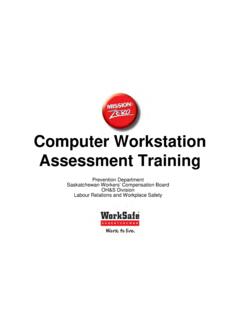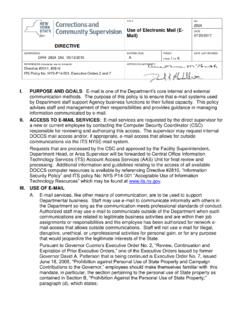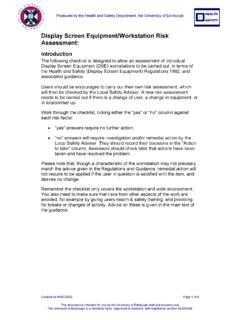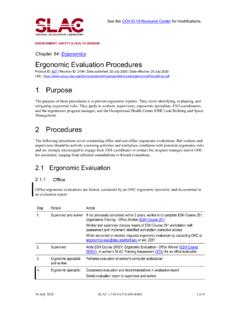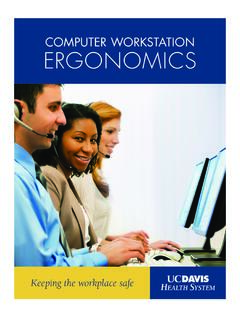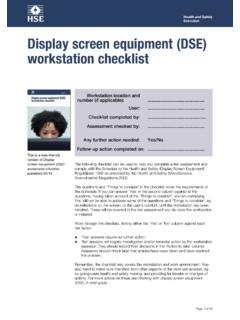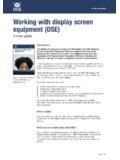Transcription of OFFICE ERGONOMICS COMPUTER WORKSTATION SELF …
1 Page 1 of 2 OFFICE ERGONOMICS COMPUTER WORKSTATION self - assessment Checklist OFFICE ERGONOMICS COMPUTER WORKSTATION self - assessment CHECKLIST Use this checklist to evaluate your WORKSTATION . For additional information, schedule a time to complete COMPUTER -integrated OFFICE ERGONOMICS training available in the Environmental Health and Safety (EH&S) OFFICE . Access the training calendar at EH&S also performs ergonomic assessments, call 556-4968 for details. WORKING CONDITIONS The WORKSTATION is designed or arranged for doing VDT, video display terminal, tasks so it allows the employee s .. Yes No A.
2 Head and neck are about upright (not bent down/back). B. Head, neck and trunk face forward (not twisted). C. Trunk is about perpendicular to floor (not leaning forward/backward). D. Shoulders and upper arms are about perpendicular to the floor (not stretched forward) and relaxed (not elevated). E. Upper arms and elbows are close to the body (not extended outward). F. Forearms, wrists, and hands are straight and parallel to the floor (not pointing up/down). G. Wrists and hands are straight (not bent up/down or sideways toward little finger). H. Thighs are about parallel to the floor and lower legs are about perpendicular to floor.
3 I. Feet rest flat on the floor or are supported by a stable footrest. J. VDT tasks are organized in a way that allows the employee to vary VDT tasks with other work activities, or to take micro-breaks or recovery pauses while at the VDT WORKSTATION . SEATING The chair .. Yes No 1. Backrest provides support for employee s lower back (lumbar area). 2. Seat width and depth accommodate specific employee (seat pan not too big/small). 3. Seat front does not press against the back of employee s knees and lower legs (seat pan not too long). 4. Seat has cushioning and is rounded/has a waterfall front (no sharp edge).
4 5. Armrests support both forearms while employee performs VDT tasks and do not interfere with movement. KEYBOARD/INPUT DEVICE The keyboard/input device is designed or arranged for doing VDT tasks so that .. Yes No 6. Keyboard/input device platform(s) is stable and large enough to hold keyboard and input device. 7. Input device (mouse or trackball) is located right next to keyboard so it can be operated without reaching. 8. Input device is easy to activate and the shape and size fit the hand of the specific employee (not too big/small). 9. Wrists and hands do not rest on sharp or hard edge.
5 Page 2 of 2 OFFICE ERGONOMICS COMPUTER WORKSTATION self - assessment Checklist 2 MONITOR The monitor is designed or arranged for VDT tasks so that .. Yes No 10. Top line of the screen is at or below eye level so the employee is able to read it without bending head or neck down/back. (For employees with bifocals/trifocals, see next item). 11. Employee with bifocals/trifocals is able to read screen without leaning head, neck or trunk forward/backward. 12. Monitor distance allows employee to read screen without leaning head, neck or trunk forward/backward. 13. Monitor position is directly in front of employee so employee does not have to twist head or neck.
6 14. No glare ( , from windows, lights) is present on the screen that might cause employee to assume an awkward posture to read screen. WORK AREA The work area is designed or arranged for doing VDT tasks so that .. Yes No 15. Thighs have clearance space between chair and VDT table/keyboard platform (thighs are not trapped). 16. Legs and feet have clearance space under VDT table so employee is able to get close enough to keyboard/input device. ACCESSORIES Yes No 17. Document holder, if provided, is stable and large enough to hold documents that are used. 18. Document holder, if provided, is placed at about the same height and distance as monitor screen so there is little head movement when employee looks from document to screen.
7 19. Wrist rest, if provided, is padded and free of sharp and square edges. 20. Wrist rest, if provided, allows employee to keep forearms, wrists and hands straight and parallel to ground when using keyboard/input device. 21. Telephone can be used with head upright (not bent) and shoulders relaxed (not elevated) if employee does VDT tasks at the same time. GENERAL Yes No 22. WORKSTATION and equipment have sufficient adjustability so that the employee is able to be in a safe working posture and to make occasional changes in posture while performing VDT tasks. 23. VDT WORKSTATION , equipment and accessories are maintained in serviceable condition and function properly.
8 PASSING SCORE = Yes answer on all working postures items A-J and no more than two No answers on remainder of checklist (items 1-23). Original checklist from the Occupational Safety and Health Administration, OSHA, web site.

